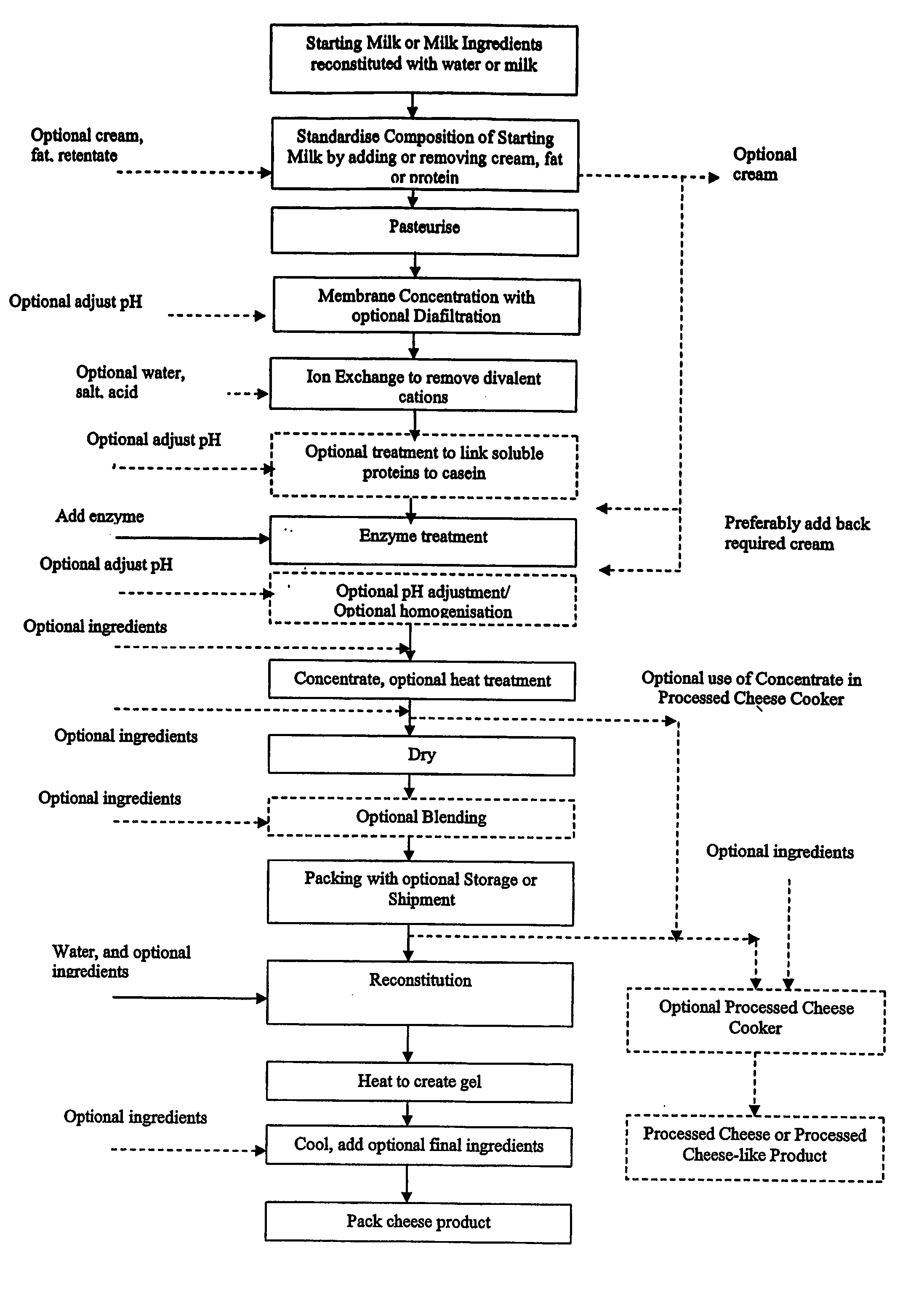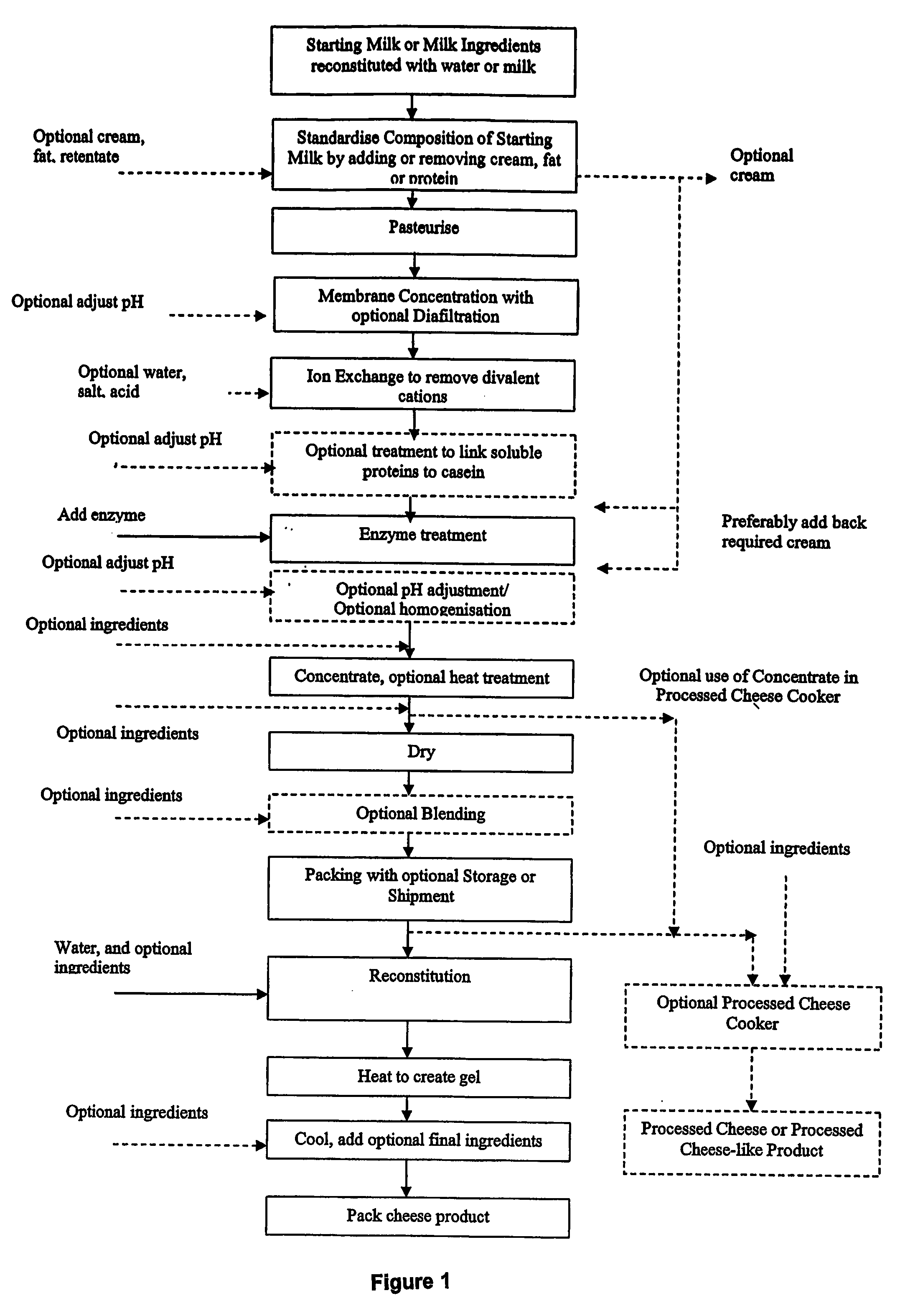Process for preparing concentrated milk protein ingredient and processed cheese made thererfrom
- Summary
- Abstract
- Description
- Claims
- Application Information
AI Technical Summary
Benefits of technology
Problems solved by technology
Method used
Image
Examples
example 1
Manufacture of High Fat Low Calcium and Renneted Ingredient
[0092] Three 25 kg bags of commercial milk protein concentrate (MPC85, ALAPRO™ 4850) were reconstituted in 50° C. water to 9% total solids. The reconstituted solution was cooled to 10° C. The cooled solution was then pH adjusted to 5.85 with 3% lactic acid solution.
[0093] Ion Exchange
[0094] The cooled pH adjusted MPC85 solution was passed through a column containing 100 L of RHOM & HAAS ion exchange resin SR1LNa to reduce the calcium concentration. Following at least 90% calcium removal, 196 kg of (40% fat) cream was added to the ion-exchanged MPC85 solution. The calcium to protein ratio of the mixture was 3,320 mg / kg (1300 mg / kg powder basis of Table 1). This corresponds to a removal of approximately 90% of the calcium that was present in the starting milk.
[0095] Cold Renneting
[0096] The mixture was renneted cold. Australian Double Strength rennet was added at a rennet to protein ratio of 0.25% to the calcium depleted,...
example 2
Efficacy of Renneting (Comparative)
[0099] Renneted solution (from example 1) was heated to 50° C. and held for 1 hour to ensure that the reaction had gone to completion. No sign of precipitation or formation of a gel was observed. To a second sample, calcium chloride solution was added in sufficient quantity to precipitate the protein. On heating the precipitate in hot water (50° C.) the precipitate firmed to a stretchy mozzarella type consistency indicating that the ion exchanged retentate had undergone sufficient renneting (in the process of example 1) to form a cheese gel but for the absence of sufficient calcium and heat. When the same test was carried out on non-renneted ion-exchanged retentate the precipitate formed was fine, non-cohesive and did not possess a gel-like texture.
example 3
Hot Renneting
[0100] Although milk is commonly treated with rennet as a batch process, effective renneting at temperatures elevated above those commonly used in cheese manufacture would enable a continuous process to be used for the renneting, concentration and drying stages of the desired process.
[0101] A 20% w / w solution of commercial medium calcium depleted MPC85 powder (NZMP 4861) (approximately 12,800 mg Ca / kg powder i.e. approximately 50-60% of the calcium removed) was reconstituted by mixing the powder in water with an overhead stirrer for 30 minutes at 50° C. The calcium to protein ratio of the solution was 15,100 mg / kg.
[0102] A sample of the reconstituted solution was taken and calcium chloride solution was quickly added in sufficient quantity to precipitate the protein. The precipitate was immediately washed in hot water (50° C.). After washing, the texture of the precipitate was fine, non-cohesive and did not possess a gel like structure.
[0103] To the remainder of the ...
PUM
 Login to View More
Login to View More Abstract
Description
Claims
Application Information
 Login to View More
Login to View More - R&D
- Intellectual Property
- Life Sciences
- Materials
- Tech Scout
- Unparalleled Data Quality
- Higher Quality Content
- 60% Fewer Hallucinations
Browse by: Latest US Patents, China's latest patents, Technical Efficacy Thesaurus, Application Domain, Technology Topic, Popular Technical Reports.
© 2025 PatSnap. All rights reserved.Legal|Privacy policy|Modern Slavery Act Transparency Statement|Sitemap|About US| Contact US: help@patsnap.com


